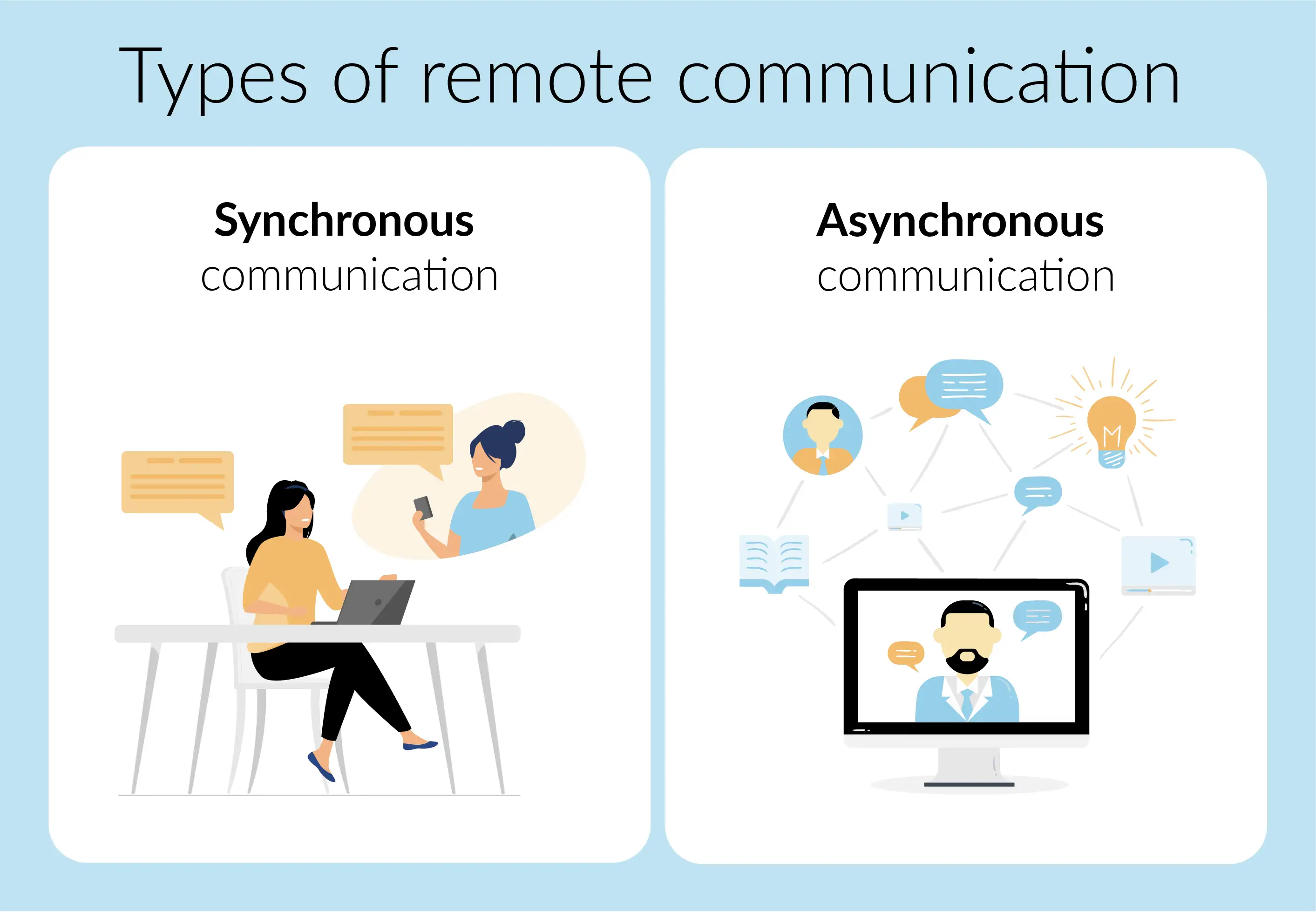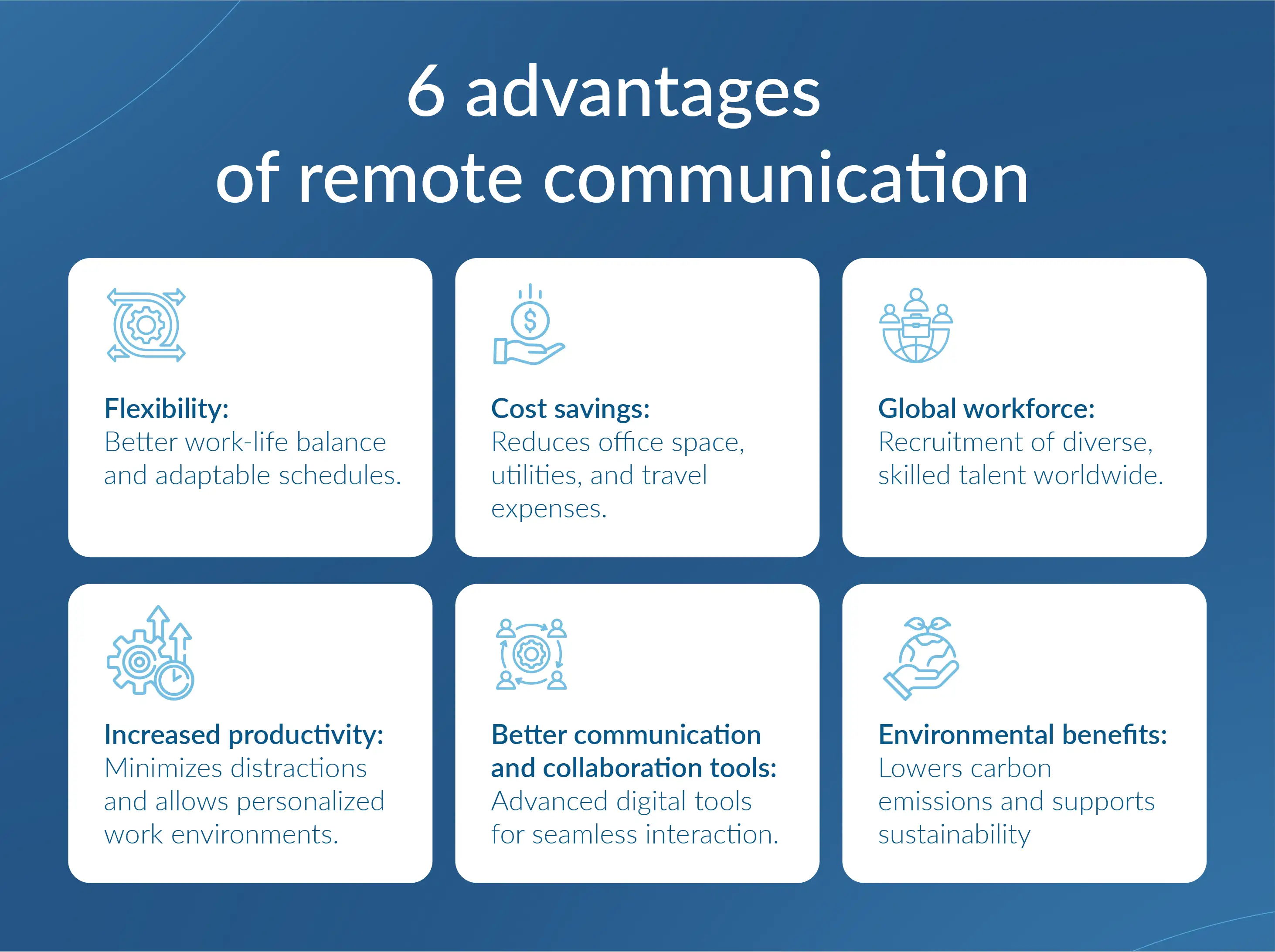Remote Communication: Effective strategies for remote teams

Communication is everything," as they say, and this is never truer than when working remotely. Communication binds the team together and ensures projects stay on track, ideas are shared, and the team meets the overall organizational goals. Remote work has become a staple for many professionals as the lines between traditional office settings and virtual workspaces blur.

What is remote communication?
Remote communication refers to sharing information and collaborative efforts between two or more people or groups who are not physically available at the same place. This mode of communication capitalizes on different digital tools and technologies for interactions, information sharing, and working collaboratively with partners across geographic locations.
Effective communication is crucial for any remote and hybrid work environment. Unlike the traditional office environment, remote work introduces challenges like time zone problems, different working schedules, and a lack of face-to-face interaction. Mastering the art of communication in this context will help remote teams to collaborate smoothly and productively while building a consistent culture despite physical distances. Remote teams can break through geographical boundaries to work toward set goals through clear and consistent communication that empowers them.
Why remote communication is important for remote employees?
Communication helps maintain a sense of connection. Remote work can easily create feelings of isolation. Regularly keeping open lines of communication helps bridge the gap between team members who are spread out over time and place, making them feel like part of the team.
- Goal alignment: Clear communication helps line up individual tasks with overall team goals. Ensuring everybody understands their due dates, responsibilities, and larger project or organizational objectives.
- Trust: When communication is frequent and transparent, it builds trust amongst the team members and also between them and their manager. If there is trust among the people working together, good collaboration is possible, giving rise to a supporting work environment.
- Feedback: Giving and receiving constructive feedback at the right time is important for personal and professional growth. It helps team members adjust their work, improve performance, and remain motivated.
- Productivity: This is because clear communication reduces the chances of errors or even miscommunication, avoiding delays and inefficiency. Thus, it ensures that a job is completed correctly and in a timely manner.
Enhancing remote work through effective communication
The digital workplace has transformed the way of working today, but it also requires new skills and strategies. Effective communication in this virtual environment keeps information flowing, allowing decisions to be made quickly while attaining goals.
Effective remote communication involves the following:
- Clarity and precision: There is no potential for misunderstanding, and everyone remains on the same page. This can be done by detailed work directions and laying down clear expectations to avoid any possible ambiguity.
- Regular updates: Regular updates must be made about the project's status, the associated deadlines, and organizational changes. Therefore, updates will keep every team member on track toward reaching the common goals.
- Feedback: Continuous improvement and maintaining motivation can only be realized with constructive feedback. Solicit and offer feedback on a daily basis so that teams remain engaged and on track toward their goals.
Types of remote communication: Choosing the right tools
Any effective remote communication must be done by choosing the right tools. There are different types of communication that serve several purposes. To execute them effectively, appropriate tools are needed. Here's an in-depth view of the various types of remote communication and their respective tools:
Synchronous communication:
- Video conferencing tools: Platforms like Zoom and Microsoft Teams are examples of those that work well for real-time engagement. They allow face-to-face meetings, a format best used for brainstorming sessions and other collaboration-based discussions. Features supported by these, such as screen sharing and breakout rooms, really do improve the quality of the meeting experience.
- Instant messaging: Slack and Microsoft Teams provide instant messaging services for faster, real-time messages. The channels and direct messages guide the conversation and help solve problems instantly.
Asynchronous communication:
- Email: It has become the go-to tool for long-winding and less time-sensitive conversations. Gmail, Outlook, and others all formalize many kinds of sharing we do, including ways to schedule and document discussions.
- Project management tools: Asana and Trello help all team members update tasks, track project progress, and communicate interactively. These tools centralize project details and status updates. Also, VPNs allow access to all of these tools wherever you are in the world
Collaborative communication:
- Document collaboration: Google Workspace and Microsoft Office 365 enable collaboration in documents and spreadsheets. Real-time editing and commenting features enhance teamwork and efficiency.
File sharing and storage:
- Cloud storage: The cloud services offered by Dropbox, Google Drive, and OneDrive make storing and sending files securely possible. These systems enable team members to coordinate from anywhere and to work together on the same document.

How can effective communication with remote workers be ensured?
Active listening is very helpful in effective remote communication. It involves paying attention to what someone else is saying and asking questions to ensure one fully understands what is being said. Also, try putting yourself in the others' shoes and empathizing with what you are replying to. Most importantly, clearly define the message. The language should be common and simple for all relevant stakeholders. Plan your meetings and express your thoughts in a way that is fair to all group members.
6 advantages of remote work
There are several advantages associated with remote communication, all of which can prove to be very effective in enhancing the collaboration process at large and increasing productivity. The following are six of the main advantages associated with it:
- Flexibility: Work from anywhere and across time zones, allowing for a better balancing of work and life and fitting personal schedules. Because of time zone differences and personal preference, flexible hours really help boost productivity and job satisfaction.
- Cost savings: The company and the employee save on costs associated with the office's physical space, utilities, and commutes to and from work. There is no need to bear the headache of frequent business trips, which saves on travel expenses and reduces associated hassles.
- Global workforce: Organizations to recruit from any country globally and bring varied skills, views, and experience into the mainstream process. The ability to hire and pool the best talent makes organizations more innovative and competitive, as it helps integrate diverse perspectives and experiences.
- Increased productivity: With the remote work environment, one may expect fewer office distractions, which usually lead to higher focus and productivity. Employees can create personalized work environments that suit their liking and boost efficiency.
- Better communication and collaboration tools: Employs the latest communication tools and platforms, such as video calls and instant messaging, to perfectly collaborate and share information. Offers immediate multi-tool communication and collaboration, raising coordination and decision-making.
- Environmental benefits: Commuter and office operation-related burdens decrease, reducing carbon emissions and other negative climatic effects. Supports remote work as a part of companies' sustainable business practices, hence assisting organizations in achieving environmental goals by not creating as much waste.

Support remote work culture with effective communication tips
Follow intentional communication practices to raise engagement and collaboration in a remote work culture:
- Open communication: Organizational updates, project status, and other major decisions should be communicated across all teams and staff to everyone's view, thereby keeping everyone engaged. Remote team members should have access to the same information as those working in the office.
- Recognition: Team and individual successes must regularly be celebrated to maintain morale and motivation. One can organize such events that are virtual in nature, including recognition programs, to recognize the achievements of milestones and successes.
- Virtual socials: To bond and cohesively unite team members, create a virtual happy hour or event. Use informal communication channels to engage people in casual conversations and socialization.
- Constructive feedback: Regular constructive feedback helps team members learn from their mistakes, correct them, and thus become motivated. It also helps team members reinvest in good behavior and performance, recognizing contributions to successes.
Establish clear communication with your remote team
Adapting these strategies, you create a communication framework that increases clarity and alignment within your remote team. Clear communication means setting up structured processes and expectations:
- Set communication guidelines: Specify what form of remote communication tools and channels should be used for which type of communication. For example, email is used for formal updates. Consider setting up expectations for the response time to avoid any delay in communication. Establish some rules regarding communication etiquette so that the message reflects professionalism and respect in all interactions.
- Schedule regular check-ins: Conduct regular team meetings to address progress, problems, and objectives. Schedule one-on-one appointments to offer individual feedback and suggestions and address concerns.
- Use a centralized platform: Use one of the major communication tools to decrease fragmentation, allowing everyone to access the same information and acting as a single source of truth.
- Inviting openness: Offer an environment where each team member is empowered and encouraged to share ideas, raise concerns, and provide feedback. Ensure all team members are present in relevant discussions and decision-making processes.
Communication tips for remote managers: Ensuring clarity and connection
Remote managers play a crucial role in ensuring effective team communication. Here are some tips:
- Be clear and concise: Relay your instructions and expectations without ambiguity to avoid misinterpretations.
- Use various means: Use several communication methods and tools to ensure vital communication reaches everyone.
- Check-in regularly: Schedule regular one-on-ones and team meetings to address action and support issues with the team.
- Open communication: Encourage members to speak their ideas and worries out; create an open platform for communication.
- Support and resources: Ensure that your team members have the necessary tools and resources to communicate and fulfill their work.
Internal communications specialist: Improving remote communication strategies
As a remote workforce grows, effective communication becomes crucial to its success. An internal communications specialist is vital in developing and implementing strategies that facilitate seamless communication among remote teams.
- Needs assessment: Review the status quo, pointing out deficiencies in the information flow, holes in the usage of tools, etc.
- Strategy development: Design strategies that enable effective communication by setting guidelines for using tools, frequency of updates, and feedback mechanisms.
- Training and support: Provide the employees with required Training on communication tools and how to use them best to be better equipped to assist in effective communication.
- Monitor and evaluate: Regularly monitor communication practices and elicit feedback to analyze their effectiveness and, thus, make adjustments.
- Best practice promoting: Share good examples and success stories that would motivate effective communication and thus create a culture of improvement.
Effective communication is crucial in remote work, fostering collaboration and productivity. Internal communications specialists play a vital role in developing strategies for seamless communication. Open communication, recognition, virtual social, and helpful feedback build up a culture of connection, which enables remote teams to work better. Remote work offers flexibility, saves costs, increases productivity, and benefits the environment in many ways.
Here's how Prezent can help improve remote communication:
Prezent uses artificial intelligence to assist in quickly making a presentation by generating slides from your content. This can save time and reduce the amount of manual effort required while creating the slides. With templates such as employee communications, employee engagement, employee performance review, or knowledge transfer, Prezent ensures consistent design and formatting across slides, maintaining a professional outlook and readability during remote meetings. Prezent can significantly enhance remote communication effectiveness for creating, sharing, and presenting information more clearly and engagingly.
Translates intricate data into user-friendly, eye-pleasing charts and graphs. As a result, team members working remotely will easily understand and analyze the information, clearly communicating it.
- Overnight presentation is a much-needed feature, especially in remote teams. It comes in handy when one needs to get up and prepare for impromptu meetings or deadlines. Using it, personnel in different time zones can benefit from ready presentations just the next working day—making for seamless cross-border communication. It serves best in case of an urgent update or change that needs to be communicated to your remote teams, ensuring everyone is always up-to-date and current.
- Get customized assistance from communication experts with our accelerator service to build high-stakes presentations. The entire process from the start to the end of the preparation and refining process of presentations, freeing more time for preparation. This is important when remote teams must quickly adjust to new information or feedback in their working schedules. It has a rich library of templates and design elements that enable a professional presentation to be built within minutes, with consistency and high-quality visuals for remote communications. Such features will automate routine tasks—think formatting and content organization—so that the remote team has more time to focus on content and strategy.
- Zenith Learning is centered on coming up with better methods of presentation and better communication. Programs on planning and delivering impactful presentations steal dispersed teams' skills toward effectively delivering their ideas. Discover the best practices of remote presentations, where you will learn how to engage virtual audiences and effectively use communication tools.
- Communication fingerprint Prezent brings this new-age capability to remote communication by personalizing presentations based on team preference, optimizing content across multiple channels, and making real-time feedback feasible. It smoothens creation and uniformity of style and combines communication fingerprints to express oneself openly.
Effective communication is more crucial than ever for remote communication. Prezent combines unique communication styles to help you express yourself openly and clearly. Join us for a personalized demo with our experts, who will guide you through the features and tools that make remote presentations not only visually engaging but also strategically aligned with your business objectives. Whether refining an existing presentation starting from scratch, our session will equip you with insights to enhance your remote communication skills.
Discover how to create compelling presentations that resonate, even from a distance. Sign up for your free demo today and start transforming your remote business communications!



.avif)








